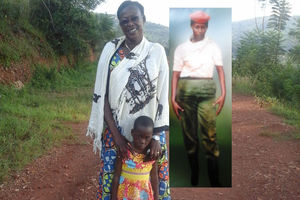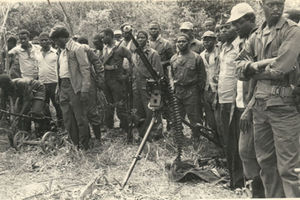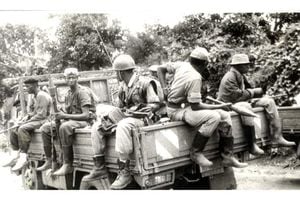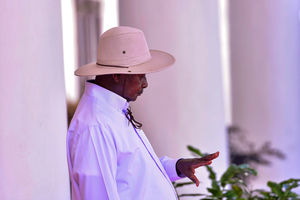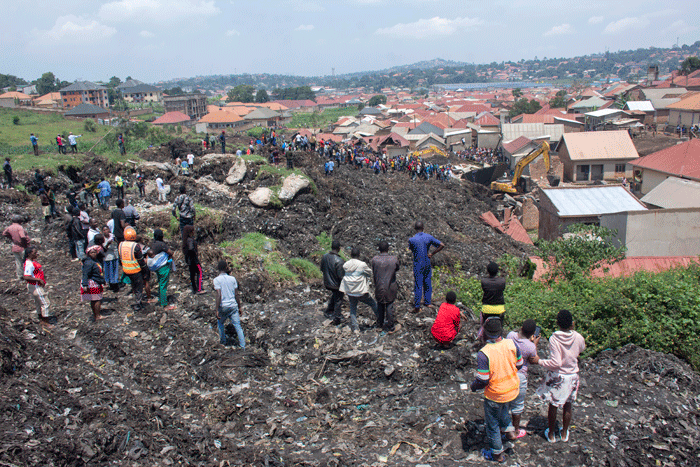
President Museveni and his Rwandan counterpart Paul Kagame during a function. The recollections by the Rwandan leader, however, differ from President Museveni’s version on the motivation of his government to send senior Rwandans in its ranks for advanced military training abroad. PHOTO | FILE
Rwanda’s President Paul Kagame, who was by last night leading his re-election bid by more than 99 percent of the votes cast, has revealed that the National Resistance Army/Movement (NRA/M) government in its early years attempted to thwart plans by Rwandan officers in its ranks to defect to launch the Rwanda Patriotic Front (RPF) liberation war.
Ugandan officials, he disclosed, moved to send four of them – who were the most senior in the new Uganda government after fighting in the NRA war that brought President Museveni to power in 1986 – for elite military training abroad after discovering their plot to decamp.
Speaking at a news conference at the former RPF tactical base in Mulindi, Gicumbi District, on Tuesday, Mr Kagame said Emmanuel Gisa, popularly known by his nom de guerre Fred Rwigyema, was handpicked for training at the General Staff and Command College at Fort Leavenworth, Kansas, in the United States while he was destined for Nigeria.
Two of their compatriots; Fred Baingana and Chris Bunyenyenzi were, respectively, designated for training in Russia and an unnamed country.
The scheme, according to Mr Kagame, was to scatter the ideologues of the nascent RPF and altogether decapitate a subversive outfit with a nucleus in Uganda against a neighbouring country, Rwanda.
“When we started organising in Uganda [to form RPF to fight the Rwandan government]…the Ugandans got to know about it,” Mr Kagame said, despite the concealment of the plan.
According to him, they had drafted many Rwandans from within and outside Uganda into the army in Uganda, which was “easy to join” due to multiple and often competing fighting groups, to form the core group to stage the liberation war.
“So, we were organising and bringing people in. [However], the Ugandan system [detected the plans and] wanted to disorganise us so that we [didn’t] remain planning [to attack Rwanda],” the Rwandan leader of thirty years said of secrets long kept under wraps.
He added: “So, when we got to know about it, I talked with Fred. I am the one who insisted and encouraged him not to actually go anywhere because that would just mess all of us up. He (Rwigyema) was our leader; so, I said ‘if you go then that means postponing it [RPF’s maiden attack] for another five years or something’. So, we agreed he is actually going to decline.”
To evade further scrutiny and show that Rwigyema was not up to mischief or being recalcitrant, Mr Kagame said they contrived a story that Ugandan authorities believed to be the legitimate reason for the former not to take the flight to the US.
The ruse worked but immediately boomeranged, according to Mr Kagame, when he was chosen as a substitute.
The future Rwandan leader said he accepted the offer, fearing they both could be arrested if he too declined the training.
“Even when I arrived at [at Fort Leavenworth for] the course I had to change the documents, everything [had been] recorded in Fred Rwigyema’s name; so, we had to change all that into my names,” Mr Kagame said.
His walk down memory lane – a route rarely publicly travelled by senior Ugandan and Rwandan political and military leaders – provided insights into the behind-the-scenes manoeuvres that enabled mainly Rwandan Tutsi exiles to use Uganda, where they were in the armed forces in large numbers, as a staging post and rearguard to attack their country of origin and take over its leadership.
RPF said its intervention stopped a genocide in which nearly 1 million Rwandans were killed within a record 100 days following the deaths of Rwandan President Juvenal Habyarimana and his Burundian counterpart Cyprien Ntaryamira when the plane carrying them was downed on landing approach at Kanombe Airport on April 6, 1994.
Mr Kagame’s lengthy account on Tuesday, last week, which was infused with rarely told personal stories, was in response to a question by a content creator Joel who asked the President: “Your name is one that is known for intentional leadership, but today we would like to know how do you take care of Paul Kagame beyond the official roles that you play”.
The recollections by the Rwandan leader, however, differ from President Museveni’s version on the motivation of his government to send senior Rwandans in its ranks for advanced military training abroad.
In an April 10, 2012 article, the New Vision quoted Mr Museveni to have said Rwigyema often spoke to him with nostalgia about his home country – Rwanda – where a sectarian government had excluded them (the Tutsi).
Put another way, the Ugandan leader was aware of the clandestine plots, with the government-owned newspaper reporting Mr Museveni’s disclosure that he used to dispatch Rwigyema to travel to Tanzania to meet Col Alexis Kanyarengwe, a dissident Rwandan officer accused at the time of plotting a coup against Habyarimana.
Mr Museveni reportedly also said Rwigyema, who had served as his bodyguard during the bush days, had briefed him about the escape to Uganda of Pasteur Bizimungu, the future first leader of post-genocide Rwanda, and a one Kajeguhakwa, and the message they brought.
“I emphasised to him [Rwigyema] the importance of doing political work to unite opinions among the Rwandans,” the New Vision reported in reference to the Hutu-Tusti divide.
President Museveni, according to the newspaper, noted: “I nominated Fred Rwigyema to go for the senior staff and command course in the US, an opportunity he passed on to Kagame because he feared that the Rwandans would have decided on an unguided assault of Rwanda if he did not watch over them.”
With Rwigyema, one of the most heroic fighters of the NRA war dead, this newspaper was unable to independently establish which of the differing accounts offered by the two presidents is accurate.
The deceased founder of the RPF and an acolyte that Museveni recruited, alongside Paul Kagame, first in late 1976 as fighters of the Front for National Salvation (Fronasa) rebel group that he led, was amongst the 41 rebels who attacked Kabamba Barracks in Mubende District on February 6, 1981, to start the NRA guerrilla war.
Many Rwandan Tutsi refugees who were living in Uganda joined the NRA rebellion after the Milton Obote II government, suspecting them of involvement in subversive activities, raided their homes and ordered them to relocate to refugee camps.
When the NRA bands ousted the Tito Okello military junta on January 25, 1986, despite the official record being January 26, President Museveni appointed Rwigyema as the deputy Army Commander and Kagame — a meticulous counter-intelligence officer during the bush war — as the Deputy Director of Military Intelligence in-charge Administration.
During the February 6, 1988 anniversary of Tarehe Sita Day, which commemorates the launch of the NRA war, the former rebels were officially decorated with military ranks. Mr Museveni invited Juvenal Habyarimana as the chief guest in an attempt to assuage fears of the leader of neighbouring Rwanda about the large numbers of Tutsi officers in the Ugandan military.
The Ugandan leader reportedly reassured Habyarimana, who witnessed Rwigyema being pipped with epaulettes, that he would ensure that the Tutsi officers in the NRA were contained.
In ranks regularisation depicting seniority of the NRA officers, President Museveni, like his brother Caleb Akandwanaho (Salim Saleh), a close friend of Rwigyema, walked off as a three-star general, with Rwigyema and Elly Tumwine, who died in August 2022, decorated to the immediate lower rank of major general.
Col Fred Bogere, a retired UPDF officer who fought in the Bush War and served as a deputy Director of Military Intelligence alongside Kagame under the overall supervision of Maj Gen Muntu Mugisha, recollects a heightened RPF activity within the rank-and-file of NRA towards October 1990.
“Rwigyema was then the deputy defence minister and would fly his helicopter to [the eastern] Jinja [City] to visit Bunyenyezi and Bangaina who were attending a senior officer’s course. They would speak till late in the night and this aroused suspicion,” he said in an interview for this article.
Rwigyema was reportedly killed on the second day of the RPFliberation war on Nyabweshongozi Hill, six miles inside Rwanda’s Nyagatare town by a sniper in Rwanda’s military of the day, although other accounts suggest associates eliminated him in a bickering over war strategy.
This was at a time of power wrangles between him, Maj Peter Baingana, a medical doctor, and Maj Chris Bunyenyezi. Bunyenyezi, Baingana, and Maj Frank Munyaneza died three weeks after Rwigyema perished.
Paul Kagame, whose return from Fort Leavenworth in the US was reportedly coordinated by the Ugandan government, succeeded the slain RPF founder reportedly with a nod by Kampala.
British author Michela Wrong in her book titled, Do Not Disturb: The Story of a Political Murder and an African Regime Gone Bad, notes that at the end of September 1990, “[President] Museveni boarded a flight to New York, where he was due to attend the United Nations General Assembly ... Rwigyema escorted the president and his delegation to the airport in Entebbe. It was the last time they would see one another, for the departure effectively marked the signal for the RPF’s plans to go into action.”
What’s more, Wrong writes, ‘The Banyarwanda boys had the perfect cover: October 9 is Uganda’s Independence Day, a state holiday traditionally marked with a massive military parade. This year, they told anyone querying why quite so many army trucks laden with young men had materialised on the roads, heading west, that the parade was being staged in Mbarara.”
On the night of October 1, Kagitumba, the main border post between Uganda and Rwanda, witnessed a mass crossing by the deserters of Rwandan origin.
Back in Kampala, there was a touch of comedy about what ensued. “Someone called me from Mbarara and said, ‘The Banyarwanda are going’,” remembers (rtd) Maj John Kazoora, then a director at Uganda’s domestic spy agency, ISO.
Unable to get then Internal Security Organisation Director General Jim Muhwezi on the phone, Kazoora drove to his house to deliver news of the questionable movement of Rwandan officers in NRA.
(Rtd) Maj Gen Muhwezi said he was not in the know, upon which the pair raced to the Army Club to inform then Army Commander Mugisha Muntu, who also was unaware. “He was equally in shock and he immediately raised the president, who was in New York,” Michela Wrong writes.
During the anniversary to mark the RPF’s Silver Jubilee in December 2012, the former Defence Minister and Rwanda’s Chief of Defence Staff James Kabareebe told the Independent Magazine that “first, the level of integration of Rwandese into the Ugandan army and our knowledge of the system created an opportunity to escape with minimum detection”.
“There was some suspicion by some Ugandan officials, of course. However, it did not generate close monitoring of our activities. Besides, even if some individuals in the Ugandan system suspected us of being up to something fishy, they would not consider our escape to be of a strategic risk.”
Kabareebe further revealed that “most critically, the war in northern Uganda allowed commanders to move around with weapons and many soldiers. And NRA had not yet developed proper administrative effectiveness to monitor and control arms and movement of soldiers”.
According to him, they had spent several months preparing for war and were placed on standby in July 1990. “We left on September 30, 1990. The vast majority of soldiers learned of the exact date of departure two or one day before the D-day. We moved from Kampala with approximately 400 people … under Maj Gen Rwigyema. We reached the (Rwanda) border on October 1 and found another 400 soldiers.”
The latter were an addition from RPF units in western Uganda. By the 10th day, the rebel fighters swelled to about 2,000, coinciding with a decision by Ugandan authorities to release Rwandans in its rank-and-file to go and join the breakaway group.
Former Prime Minister Amama Mbabazi, who accompanied President Museveni at the time to New York, told author Wrong that the Ugandan leader “tried to call [Rwandan President] Habyarimana, who was staying in the same hotel as us, in order to warn him”.
“The operator refused to put the call through, saying ‘Habyarimana was not to be disturbed’. So, Museveni rang the Rwandan foreign minister and asked him to wake up Habyarimana and tell him. And the foreign minister said ‘there was no way he was going to do that’,” the author notes of her conversation with Mr Mbabazi.
During the Tuesday news conference in Rwanda, President Kagame waded into the murky subject of the assassination of his predecessor, Habyarimana, on April 6, 1994, when returning alongside his Burundian counterpart from peace talks between the Hutu and the Tutsi in Arusha, Tanzania.
Mr Kagame said he was notified of the plane explosion while watching an African Cup of Nations match at the same grounds where he spoke on Tuesday. The Rwandan leader said he at the time was living with his son Ivan, then aged 3, whom he had to convince and cajole to depart to stay with his mother in Uganda after Kagame himself headed to the frontline.
